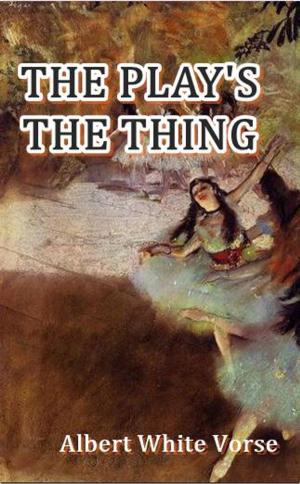| Author: | Geoffrey Clarke | ISBN: | 1230001837032 |
| Publisher: | Geoffrey Clarke Associates | Publication: | May 5, 2014 |
| Imprint: | Language: | English |
| Author: | Geoffrey Clarke |
| ISBN: | 1230001837032 |
| Publisher: | Geoffrey Clarke Associates |
| Publication: | May 5, 2014 |
| Imprint: | |
| Language: | English |
The aim of this book is to define the nature of literary collaboration by authors in the mediation and production of the novel of masculine action in the period 1880-1905. Collaboration in texts is a very interesting problematic that becomes more marked in the late-Victorian period. I have analysed the nature and motivation on which various literary collaborations rested, looking at the issue of sexuality within the texts and at the disputes that arose and the rivalries that existed within the male bonded community. The book explores the anxieties and suppressions that characterise such collaborative male ventures, and undertakes research into constructions of masculinity and gender differentiation. It engages critically with ways in which masculinity, in the late-Victorian period and subsequently, has been accepted as a matter of fact and "given"; and, in terms of theory, the book is tied to, and attempts to extend recent work in gender and cultural studies.
Some of the sources I have used for this study have been Double Talk by Wayne Koestenbaum, and both Epistemology of the Closet and Tendencies by Eve Kosovsky Sedgwick. I have also been significantly influenced in this project by Heath’s “Psychopathia Sexualis”, by William A. Cohen’s Sex Secrets, and The Poetics of Gender by Nancy K. Miller. Their work on literary collaboration has been influential in forwarding scholarship on queer theory, not least by allowing for new ways of looking at masculinities and femininities, and ways in which these altered in the late-Victorian period.
I have approached my work in three ways, looking at three essential themes — literary collaboration, Empire and sex. Firstly, I examine literary collaboration in many of its manifestations because it is different from other more conventional ways of producing texts. There exist some key novels including Haggard’s She, King Solomon’s Mines and The World’s Desire arising from the collaboration of authors. I look at the nature of collaboration and male bonding within the text of the novel, pointing to the homoeroticism that is often contained within the stories. I demonstrate an interest in the nature of collaboration and male bonding within the discourse I examine. This leads to issues of homosociality which I deal with in some detail.
Secondly, I analyse the impact of Empire and consider the ways in which it is reflected in the novels of masculine adventure, exerting, as it did, a remarkable influence upon British youth. I particularly challenge the notion that Empire was a benign institution, as has been suggested by some recent commentators. I will argue that Empire provided the geographical scope and possibility for adventure and often influenced the successful works featured in this survey.
Lastly, I highlight sex and show that there are a number of texts that deal with the matter in particularly interesting hidden, unconscious ways that are suggestive and erotic and often point to the homosociality of the writers. There appears to be an unspoken homoeroticism underlying much of the literary discourse that I deconstruct, which may have arisen from either commercial or theoretical literary concerns. These texts include She, on which Haggard collaborated with Lang, Conrad’s Heart of Darkness, and the joint work by R. L. Stevenson and his stepson Lloyd Osbourne, The Ebb Tide.
In terms of methodology, I have employed traditional literary criticism allied with qualitative approaches to research, such as family letters, portraits on canvas, evidence from correspondence between authors, handwriting in the original texts, period plate photographs, correspondence between the present author and living and erstwhile members of the Haggard family, previously unknown correspondence between Ford and his publisher, and evidence from ring-giving between Haggard and Lang taken from period plate photographs of the time.
Where it has been possible, I have attempted to relate the success or otherwise. of the original texts to the production, reception and distribution of similar novels of the period. In many cases, I have analysed the sales figures of the various editions of the works showing, for example, how King Solomon’s Mines and Kipling’s Barrack Room Ballads’s production figures grew in strength over time.
In terms of social history, the book refers, where necessary or appropriate, to late-Victorian values, ideals, and the suppressions and repressions that some researchers tend to think of as symptomatic of the era. These include the system of primogeniture that passed wealth, land and the perpetual inheritance of titles to the first born in an aristocratic family, leading to our present system of unelected peers.
Masculinities and femininities in the period are looked at, and a comprehensive literature review is undertaken on the subject. Obviously it is difficult to relate such issues specifically to the time in question because, from our present-day perspective, we have vastly altered ideas on gender and queer studies.
The aim of this book is to define the nature of literary collaboration by authors in the mediation and production of the novel of masculine action in the period 1880-1905. Collaboration in texts is a very interesting problematic that becomes more marked in the late-Victorian period. I have analysed the nature and motivation on which various literary collaborations rested, looking at the issue of sexuality within the texts and at the disputes that arose and the rivalries that existed within the male bonded community. The book explores the anxieties and suppressions that characterise such collaborative male ventures, and undertakes research into constructions of masculinity and gender differentiation. It engages critically with ways in which masculinity, in the late-Victorian period and subsequently, has been accepted as a matter of fact and "given"; and, in terms of theory, the book is tied to, and attempts to extend recent work in gender and cultural studies.
Some of the sources I have used for this study have been Double Talk by Wayne Koestenbaum, and both Epistemology of the Closet and Tendencies by Eve Kosovsky Sedgwick. I have also been significantly influenced in this project by Heath’s “Psychopathia Sexualis”, by William A. Cohen’s Sex Secrets, and The Poetics of Gender by Nancy K. Miller. Their work on literary collaboration has been influential in forwarding scholarship on queer theory, not least by allowing for new ways of looking at masculinities and femininities, and ways in which these altered in the late-Victorian period.
I have approached my work in three ways, looking at three essential themes — literary collaboration, Empire and sex. Firstly, I examine literary collaboration in many of its manifestations because it is different from other more conventional ways of producing texts. There exist some key novels including Haggard’s She, King Solomon’s Mines and The World’s Desire arising from the collaboration of authors. I look at the nature of collaboration and male bonding within the text of the novel, pointing to the homoeroticism that is often contained within the stories. I demonstrate an interest in the nature of collaboration and male bonding within the discourse I examine. This leads to issues of homosociality which I deal with in some detail.
Secondly, I analyse the impact of Empire and consider the ways in which it is reflected in the novels of masculine adventure, exerting, as it did, a remarkable influence upon British youth. I particularly challenge the notion that Empire was a benign institution, as has been suggested by some recent commentators. I will argue that Empire provided the geographical scope and possibility for adventure and often influenced the successful works featured in this survey.
Lastly, I highlight sex and show that there are a number of texts that deal with the matter in particularly interesting hidden, unconscious ways that are suggestive and erotic and often point to the homosociality of the writers. There appears to be an unspoken homoeroticism underlying much of the literary discourse that I deconstruct, which may have arisen from either commercial or theoretical literary concerns. These texts include She, on which Haggard collaborated with Lang, Conrad’s Heart of Darkness, and the joint work by R. L. Stevenson and his stepson Lloyd Osbourne, The Ebb Tide.
In terms of methodology, I have employed traditional literary criticism allied with qualitative approaches to research, such as family letters, portraits on canvas, evidence from correspondence between authors, handwriting in the original texts, period plate photographs, correspondence between the present author and living and erstwhile members of the Haggard family, previously unknown correspondence between Ford and his publisher, and evidence from ring-giving between Haggard and Lang taken from period plate photographs of the time.
Where it has been possible, I have attempted to relate the success or otherwise. of the original texts to the production, reception and distribution of similar novels of the period. In many cases, I have analysed the sales figures of the various editions of the works showing, for example, how King Solomon’s Mines and Kipling’s Barrack Room Ballads’s production figures grew in strength over time.
In terms of social history, the book refers, where necessary or appropriate, to late-Victorian values, ideals, and the suppressions and repressions that some researchers tend to think of as symptomatic of the era. These include the system of primogeniture that passed wealth, land and the perpetual inheritance of titles to the first born in an aristocratic family, leading to our present system of unelected peers.
Masculinities and femininities in the period are looked at, and a comprehensive literature review is undertaken on the subject. Obviously it is difficult to relate such issues specifically to the time in question because, from our present-day perspective, we have vastly altered ideas on gender and queer studies.















